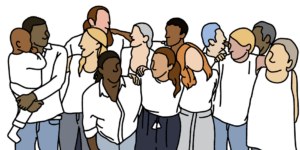Emma Bowkett from Neighbourly Lab shares what their Moment To Connect research has taught them about informal volunteering.

Stepping up to help out: How do ‘community helpers’ play a role in informal volunteering?

Neighbourly Lab were awarded a grant by Spirit’s Moments To Connect fund to conduct research to better understand how people across the UK help out in their communities especially for national moments like the Coronation. They found that those that give time to a cause or interest feel happier and more connected to their communities. Here, Emma Bowkett shares what else they found out. To learn more, join their webinar on July 6th where they will discuss their upcoming report
As we know, ‘helping out’ or more specifically ‘informal volunteering’ rose to prominence during the pandemic, when the face of volunteering changed to suit new needs, different people and contexts. Millions of people stepped up to help others in the form of hyper local support networks, and whilst some of this activity naturally dwindled with changing needs, this type of helping out still resonates with us, especially in light of the cost of living crisis and people wanting to support others, but being stretched in many different ways and therefore less able to give as much time.
Therefore, alongside this rise of informal volunteering, we are seeing that the rate of people formally volunteering has been declining. In 2019/20, 29.4m people formally volunteered once that year, however in 2020/21, that number sharply declined to 16.3m people formally volunteering at least once 1 Due to this decline, organisations who are reliant on volunteers are struggling, and are increasingly thinking about how they can mobilise more people to give their time and different ways of recruiting volunteers.
So, we wanted to explore what ‘helping out’ looks like from the experience of those taking part in it and what can be done to encourage more people to get involved. We looked at this in the context of the King’s Coronation, and the Big Help Out in which 6.5 million people came together to celebrate with one another and to help out in their local community. National moments were an exciting lens through which to look, due to their reliance on volunteers, their often place based focus, the opportunity that they present to catalyse volunteering and bring people together .
1 https://www.ncvo.org.uk/news-and-insights/news-index/uk-civil-society-almanac-2021/volunteering/#/
Our approach
We adopted a mixed methods approach, using both qualitative, ethnographic and quantitative research, specifically looking at what motivates and prevents people from helping out and how this translates into ‘reimagining volunteering in our ‘communities’.
We captured the perspective of those already participating in helping out in their community, those aspiring to do so and also people who were formally volunteering.

Our findings
A key finding of this research is that there is a huge underutilised helpforce of two types of volunteers, ‘community helpers’, who are people that already contribute and help out in their community in an ad hoc way, and ‘community helper aspirers’, who are people that aspire to help out in their community, perhaps have done so in the past, but aren’t yet currently. The reason we see this helpforce as underutilised is because these two cohorts of people made up the bulk of both the Coronation and Big Help Out helpforce. According to our quant research, over 80% of those who helped at either the Coronation or the Big Help Out were community helpers and community helper aspirants.
So why is this significant? This is a group that is underutilised by big national charities, because they are often not factored into traditional recruitment strategies and volunteer management processes. But, from these stats we can see they are motivated to help out and there are many more of them than there are formal volunteers. Given the decline in formal volunteers taking part in national or regular events that require time commitments, this large number of community helpers are a hugely valuable resource. We think that in order to mobilise more volunteers, volunteering organisers need to look through the lens of the people who are, or could be community helpers and therefore adapt how they look to mobilise support.
Interestingly, we discovered that a sense of community is vital, current community helpers and aspirants strongly relate to feelings of belonging to their local area. With many current community helpers aligned to this perspective, “this is my area, born and bred here. Whatever I can do for the area, I’d love to”. We found that both formal volunteers and community helpers are more likely to feel a sense of belonging to their local community, compared to those who do not help out at all. So, place is a significant enabler to get people involved in helping out especially within tight knit communities, so recruitment processes need to factor that in when targeting new volunteers as highlighting that participants are likely to contribute to their community will likely motivate people to help out.
We found that over half of survey respondents want to help out when they can but not regularly. People do want to give their time, but they don’t want to make huge commitments. With this need for flexibility, people’s volunteering journey is not always linear; they don’t always want to work their way up the ladder to gain more responsibility, skills or experience. Many feel that, “I don’t want to feel like this is a job, I want to be able to dip in and dip out when it comes to helping out”. It is vital that volunteering infrastructure is set up to support people to get involved in this flexible way and organisers need to be aware that for this group this journey is not always linear in the way that formal volunteering can be.
When looking at what motivates people to help out, people are most likely to give their time to something that they find rewarding and also for an initiative or activity that they will get meaning out of. Importantly, this could be a cause close to their heart, something rewarding or for an activity that simply they just find fun. People aren’t always viewing volunteering as something entirely altruistic, it has to be something that will benefit them and that they feel is a valuable use of their time.
Our recommendations
As we have emphasised, ‘community helpers’ are a highly valuable asset. There are many people that are already doing this sort of activity, playing a vital role in a historic national moment like the Coronation. We view these national moments as key because they’re often open for anyone to take part in, they don’t require a huge time commitment and they’re an excuse for people to get together. Given this, what can volunteering organisations take from these learnings centred around the Coronation to adopt within their own strategies?
Firstly, focus on what motivates people to help out in their community or for a cause. How can you diversify your volunteering offer to allow current or aspiring community helpers to participate in a flexible, rewarding and community based way that they would prefer?
Also, when thinking about what motivates people, harness your efforts on ensuring that community helper aspirers can become helpers What do they need to get involved in helping out within their community, and what can we learn from the experience of current community helpers and how they started to help out?
There is massive value in community helpers, but there is also huge value in formal volunteers from a managerial perspective. Especially as they are more likely to follow the linear journey of the volunteering ladder, to want to develop new skills, take on more responsibility and a larger time commitment. Formal volunteers are more able to take on managerial roles and to get involved in the planning of national moments events. So they can play an integral role in supporting ‘community helpers’ to participate in a meaningful and valuable way within these national moments.
We see these formal volunteers and community helpers forming into a two tier structure when it comes to a volunteer helpforce. With formal volunteers taking on the more managerial roles and community helpers providing a support function. It is vital to have both types of volunteers to ensure that events are well managed, but also so that you have enough people to contribute.
We believe that these findings are interesting for organisations relying on volunteers as they highlight that volunteering recruitment strategies could and should be restructured to accommodate the needs and motivations of ‘community helpers’, whilst also not neglecting the value that formal volunteers bring.
Learn more
Volunteers Week 2023: how do we sustain volunteering long-term?
The Year of the King: how one community used the Coronation to connect people
How do people feel about volunteering ahead of the Coronation weekend?
